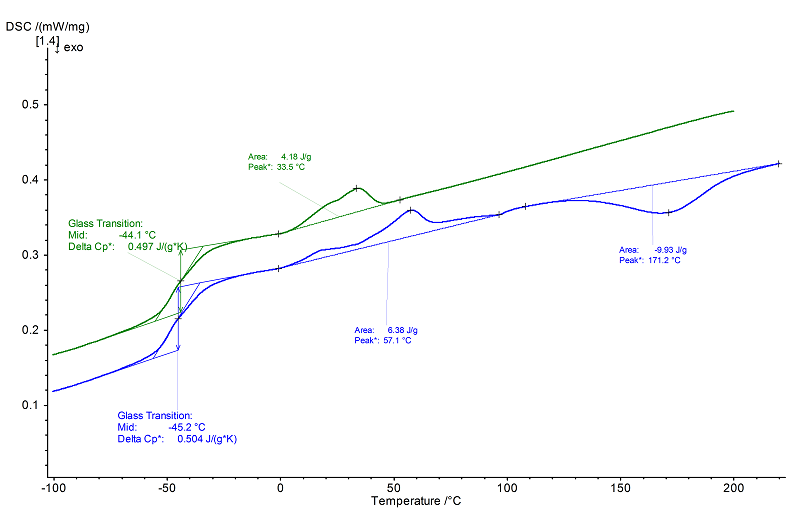SBR: Styrene-butadiene rubber
- Short Name
- SBR
- Name
- Styrene-butadiene rubber
- Group
- EM - Elastomers
- General Properties
- Chemical Formula
- Structural Formula
-

Properties
- Glass Transition Temperature
- -55 to -35 °C
- Melting Temperature
- (-20) °C
- Melting Enthalpy
- (170 (cis)) J/g
- Decomposition Temperature
- 435 to 470 °C
- Young's Modulus
- 2 to 10 MPa
- Coefficient of Linear Thermal Expansion
- 180 *10¯6/K
- Specific Heat Capacity
- 1.88 to 2.00 J/(g*K)
- Thermal Conductivity
- 0.20 to 0.25 W/(m*K)
- Density
- 0.94 g/cm³
- Morphology
- Rubber with hard and soft segments
- General properties
- Good aging and abrasion resistance
- Processing
- Cross-linking by means of sulfur accelerating systems or peroxides
- Applications
- Tire industry (cap of tires). Technical rubber goods (conveyor bands, seals). Mechanical engineering. Household articles (e.g., shoe soles)
Internet Links
NETZSCH Measurements
- Instrument
- DSC 204 F1 Phoenix®
- Sample Mass
- 13.10 mg
- Isothermal Phase
- 8 min
- Heating/Colling Rates
- 10 K/min
- Crucible
- Al, pierced
- Atmosphere
- N2 (40 ml/min)

Evaluation
In the DSC curve from the 1st heating (blue), SBR shows a glass transition at -45°C (midpoint), a broad, complex melting transition (with peak temperatures at 19°C and 58°C and a melting enthalpy of approx. 6 J/g in the 1st heating), caused by the
melting of additives and an exothermal effect (peak temperature: 168°C, enthalpy: approx. 10 J/g) that can be attributed to post-vulcanization. This exothermal effect is absent in the 2nd heating (green) after controlled cooling, indicating that vulcanization was completed in the 1st heating. As a result, the Tg in the 2nd heating is shifted to a slightly higher temperature (midpoint of -44°C compared to -45°C in the 1st heating). The step height (Δcp) of approx. 0.5 J/(g·K) remained almost
unchanged. This small effect of post-cross linking on temperature and height of the glass transition step is typical for elastomers.
A melting transition due to additives with peak temperatures of 23°C and 34°C and an enthalpy of approx. 4 J/g is also seen in the DSC curve of the 2nd heating.
melting of additives and an exothermal effect (peak temperature: 168°C, enthalpy: approx. 10 J/g) that can be attributed to post-vulcanization. This exothermal effect is absent in the 2nd heating (green) after controlled cooling, indicating that vulcanization was completed in the 1st heating. As a result, the Tg in the 2nd heating is shifted to a slightly higher temperature (midpoint of -44°C compared to -45°C in the 1st heating). The step height (Δcp) of approx. 0.5 J/(g·K) remained almost
unchanged. This small effect of post-cross linking on temperature and height of the glass transition step is typical for elastomers.
A melting transition due to additives with peak temperatures of 23°C and 34°C and an enthalpy of approx. 4 J/g is also seen in the DSC curve of the 2nd heating.